Gigabyte's GA-MA785GPMT-UD2H - AMD's 785G is Here, Sort of...
by Gary Key on July 14, 2009 11:00 PM EST- Posted in
- Motherboards
Like a good spy, we searched all over two continents for a motherboard containing AMD's 785G chipset. Once we identified our target, we scoped it out, formulated a snatch and grab plan, and then waited until the time was right. We thought the time was right last week to swoop in and grab the object of our desire. Sure enough, the plan went off without a hitch as we brought the Gigabyte GA-MA785GPMT-UD2H back to the labs for integration. Before we could even try our hands at waterboarding Gigabyte's latest multimedia wonder, testing came to a grinding halt.
It seems that in our rush to secure this motherboard that we overlooked one very important aspect during our investigation. It turns out the driver set we were privy to for testing is an early beta set missing several important driver features while AMD is still optimizing performance. We encountered no stability problems running a multitude of benchmarks, but the lack of features and optimizations preclude us from publishing a meaningful first look, especially for those looking to use this new platform in an HTPC or SFF gaming system. Of course, there were discussions with AMD explaining some of the early problems we ran into during testing. As such, AMD requested that we wait until the drivers are mature and based on early test results we will heed their requests.
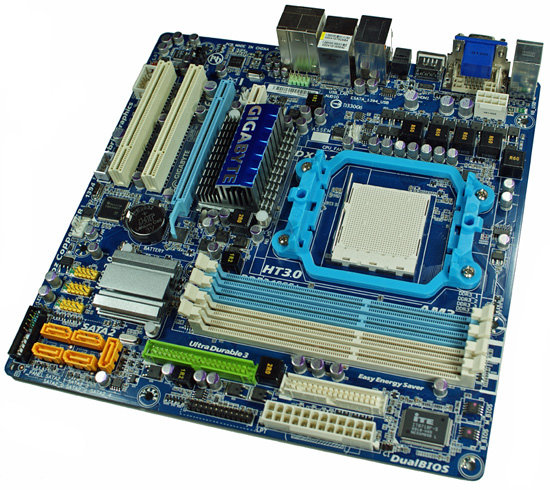
What we can do today is discuss some early observations and provide a couple of results that are indicative of the board's capability with an early BIOS and a quick look at Blu-ray playback results. First off, even with less than stellar drivers, the board's performance was equal to or better than the current 780G/790GX motherboards and it will only improve. How much is up for discussion as AMD designated the new chipset just a half point higher for a reason.
The graphics core in the 785G is upgraded from the HD3200/3300 utilized in the 780G/790GX to the HD4200. The primary difference between the cores is that the HD4200 fully supports DX10.1, Unified Video Decoder 2.0 (UVD), hardware accelerated picture in picture capabilities, dynamic contrast, HQ video scaling, hardware accelerated video transcoding, and full Powerplay support. The graphics core still runs at 500MHz (in current form) and at least in our particular sample, we were able to reach 1057MHz without too much trouble.
What does all this mean? For one, thanks to the HD4200, AMD finally offers multi-channel LPCM audio output plus additional hardware video accelerated functions. As far as performance is concerned, expect a 5%~ 15% performance increase in games. That sounds impressive, but playing the Sims3 at 1024x768 with medium quality settings resulted in an average framerate increase from 23.9fps on the 780G to 26.1fps on the 785G with alpha level drivers. The biggest difference occurred in minimum frame rates with an increase from 12fps on the 780G to 15fps on the 785G. Otherwise, the GPU capabilities are fine for casual gaming (Plants vs Zombies) and flash based games.
Of course most users purchasing this type of product are not that interested in gaming and if you are, then we highly suggest buying a HD 4770 or HD 4850 for 1680x1050 or below resolutions. Anything higher, and we suggest a HD 4890 based on current price to performance ratios. The main purpose of this chipset is to capture the mainstream desktop market, you know, the market where 90% of units sold are with integrated graphic capabilities only.
When paired with the Athlon II X2 250 processor we utilized in early testing, this platform is an extremely compelling alternative to the Intel G41/E6300 combination. Considering the number of features and platform performance that AMD provides with the 785G/SB710 chipset compared to the G41/ICH7, we have to wonder why one go the Intel route, even this early in the game. Our original plans called for a direct comparison between the two platforms but that will have to wait until the official release next month with production ready drivers. AMD will have an official release candidate ready shortly and we expect the boards to ship with the 9.8 Catalyst driver set.
That said, early results with HD video playback are very promising. However, the majority of missing driver features center on the lack of Avivo options. Vector Adaptive de-interlacing was working in our driver set with Aero enabled under Windows 7 Ultimate x64 (build 7600), but we noticed some slight edge flickering in titles like Wanted and The Dark Knight. The entire Avivo section in the driver set is missing so we do not know if features like HD Color Vibrance, HD Flesh Tone, HD Pulldown detection, HD edge enhancement, and dynamic contrast will be fully supported or not. We have asked the question and will have an update once we get an answer. 1080p/24 support is working properly as is multi-channel LPCM audio output through several A/V receivers.
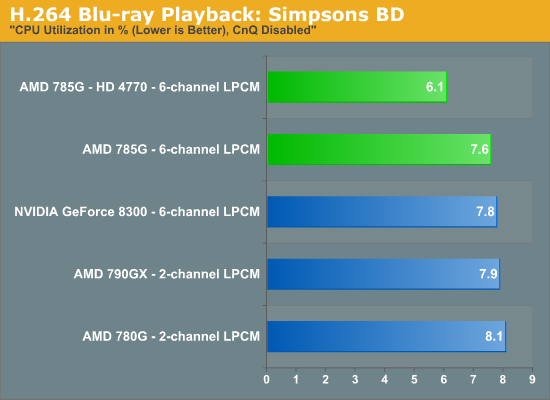
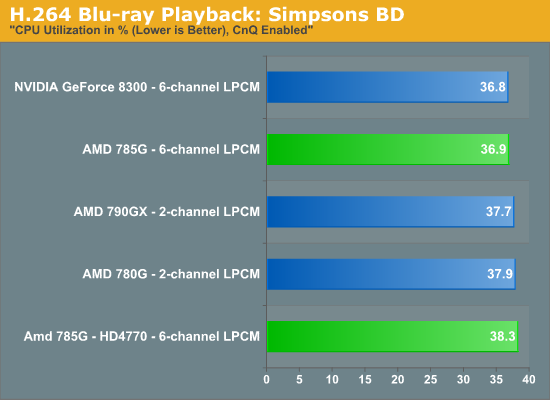
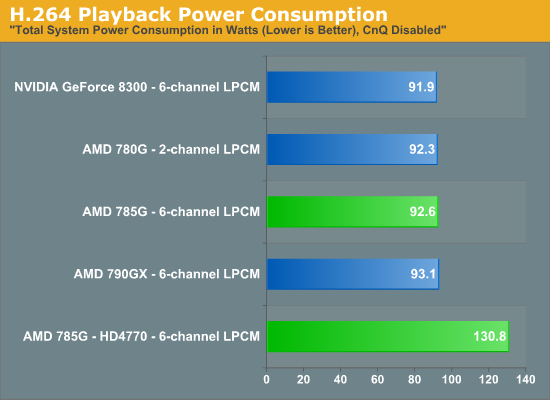
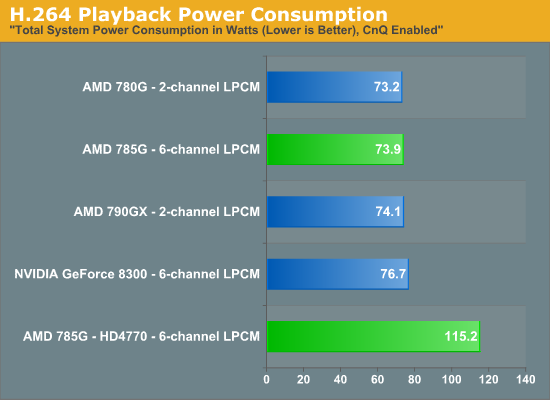
In our only test today we see very good results in the Blu-ray playback capabilities of the 785G. So much so, that unless something drastic happens in the next driver release, we will stop recommending the purchase of a discrete video card on the AMD chipset platforms. We did not have any HDMI incompatibilities, no repeater issues to report, the 785G just worked and we think it will only get better.
Gigabyte has produced yet another sterling uATX motherboard that is fully featured. The full specification sheet is in our Gallery. We will not get into the all of the specifics today but one question that needs to be answered concerns the ability of the chipset/board to unlock the Athlon II X2 550 or Phenom II X3 720BE processors as one example. This board had no problems unlocking our particular retail units although your mileage will vary based on processor quality and BIOS options.
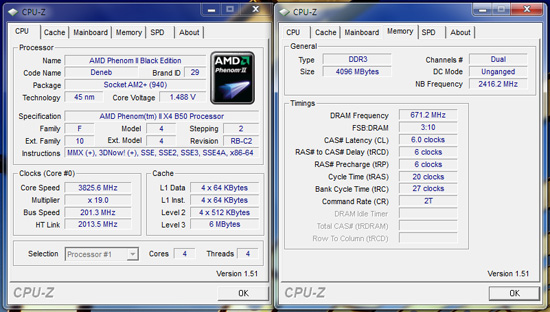
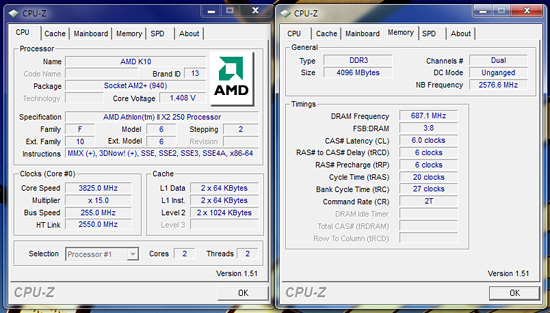
We utilized a retail Phenom II X4 955BE heatsink/fan for our overclock results. These coolers work great for overclocking either Athlon II X2 processor. The Athlon II X2 550 BE is unlocked with all four cores working properly and a nice stable overclock to 3.825GHz (19x201) on 1.50V. Our Athlon II X2 250 had no problems reaching a stable 3.825GHz (15x255) on 1.425V. We are using Windows 7 x64 so our final clock speeds are limited somewhat by the 4GHz ceiling we typically run into with the Phenom II/x64 combination.
That is it for our preview follow-up, suffice to say that AMD has produced another very good chipset that provides the most cost effective IG performance in the market. The Gigabyte GA-MA785GPMT-UD2H is quickly shaping up to be one of the boards to have when the 785G launches next month.






















30 Comments
View All Comments
RadnorHarkonnen - Wednesday, July 15, 2009 - link
When will this land on lappy land ? HD3200 had very low penetration, i would if this chipset will be associated with Turion CPUs. It was a nice way to have a decent GPU with HDMI and some bells and whistles.Thanks
Spoelie - Wednesday, July 15, 2009 - link
Will AMD update their drivers to include support for AVC L5.0/5.1 spec decoding? Currently 4.1 is supported as this is the spec BluRay uses.http://forums.amd.com/game/messageview.cfm?catid=2...">http://forums.amd.com/game/messageview....&thr...
While one can argue the relevance of the L5.0 spec outside of "scene releases" if there are currently no broad consumer products like BluRay that use it, but there are 2 problems with that:
*As indicated, there are official trailers released in this spec, and I assume as time passes, more material will use it.
*Regardless of its use, NVIDIA DOES support L5.0 spec, this will drive the HTPC nut (and warezerers) to their cards = lost sales
The hardware should be capable, it's purely a driver issue.
R3MF - Wednesday, July 15, 2009 - link
It is rumoured to keep the 40 shaders of the previous generation.And yet we know that the smallest 4xxx series chip used 80 shaders.
So, is the 785G a rebranded 3450 chip, or is it a cut down 4350 chip?
And why did AMD decide to cede leadership of the IGP to nVidia/Intel after ruling the roost with the 780G for so long? This new IGP should have had a genuine 80 shader 4xxx series GPU.
AlB80 - Wednesday, July 15, 2009 - link
1. RS785G is just respin RS780G. It's has same 40 ALU, but DX10.1 capable. Additional it's has UVD2 instead UVD+.So, it's looks like step from HD2400 to HD3400 in 3D, and from HD3xxx to HD4xxx in video acceleration.
2. Anybody knows are there HD4xxx changes in the texture and ROP units? If it so then HD4200 is indeed HD4xxx core, but most weakest of all.
mczak - Wednesday, July 15, 2009 - link
There are quite a few differences between rv6xx and rv7xx chips. ROPs can do twice the amount of z comparisons, plus handle msaa natively without shader resolve.Texture units no longer handle FP16 textures in one clock, but much smaller in size plus seem to have improved efficiency. And more importantly, tmus are no longer shared across shader clusters, but each cluster has its own quad-tmu (thus, a 40SP part with 4 tmus would have 1 shader array with length 8, instead of a rv6xx part where such a part will have 2 arrays with length 4).
All rumours seem to say rv620 graphic core, though.
AlB80 - Wednesday, July 15, 2009 - link
1. I did a typo. I known about changes inside HD4xxx, my question was are this changes applied to HD4200? Without this information we can't say what is it. rv620 or cutted rv710.2. rv730 has length 4. It's looks like very flexible architecture.
mczak - Wednesday, July 15, 2009 - link
well without these changes it wouldn't be a rv7xx part.And rv730 has shader array length of 8, just like rv710 (rv770/rv740 have array length 16). Not to say that a even more cut down version couldn't have 4, but this would mean two shader arrays (with 40 shader units), hence 2 quad-tmus (8 texture units).
AlB80 - Thursday, July 16, 2009 - link
1. Note. rv670 have 4 arrays with length 16.2. When I say "cutted rv710" I mean that one array will be removed at all. And then cutted rv710 will be architectural look like rv620. And only information about texture and rop units can discover the truth.
mczak - Thursday, July 16, 2009 - link
I don't follow you there. Sure rv670 had 4 arrays with length 16. Hence 16 tmus (need as many tmus as shader length since they are shared across arrays). But with rv7xx, you can't have 2 shader arrays with 4 tmus since each array has its own quad-tmu (I guess though it would in theory be possible to have two dual-tmu blocks but then you're talking more difference to rv7xx parts). Hence one array with length 8. But the rv620 had two arrays with length 4.But I think it really is rv620 - there was some statement somewhere it supports hybrid-crossfire with HD34xx - I doubt that would be possible with a rv7xx part.
Anyway, looks like it will soon be on sale so someone will figure it out...
AlB80 - Thursday, July 16, 2009 - link
I understood.